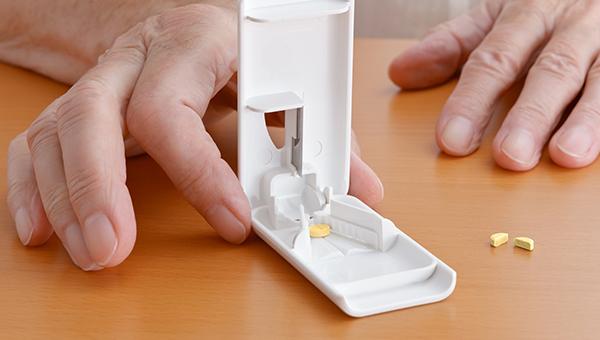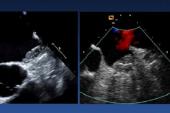Half-Dose DOAC May Be a Good Post-Watchman Option
In this observational study, half-dose DOACs cut device-related thrombosis compared with the standard approach.

After left atrial appendage (LAA) occlusion with the Watchman device (Boston Scientific), an antithrombotic strategy centered on a half-dose of a direct oral anticoagulant (DOAC) may improve outcomes compared with the standard antiplatelet-based approach, a nonrandomized study suggests.
No patients treated with half-dose DOAC therapy across three centers developed device-related thrombosis (DRT) over about a year of follow-up, whereas 12 patients (3.4%) treated with a standard regimen—ie, 45 days of a DOAC plus aspirin, followed by aspirin plus clopidogrel up to 6 months and then aspirin monotherapy indefinitely—developed the complication (P = 0.009).
Thromboembolic events and major bleeding were less frequent with the half-dose regimen, too, researchers led by Domenico Della Rocca, MD (Texas Cardiac Arrhythmia Institute, St. David’s Medical Center, Austin), report. Their study was published online Wednesday ahead of print in JACC: Cardiovascular Interventions.
“I think this approach can potentially replace what we have done so far,” Della Rocca told TCTMD, acknowledging both the limitations of an observational analysis and the need to confirm the results in a randomized trial. Multiple studies have demonstrated an activation of coagulation factors but not platelets after Watchman implantation, he noted. “So we are providing protection in terms of thromboembolic events with the device and we are providing protection in terms of thromboembolic events related to the DRT with a low dose of anticoagulation. And also we are preventing a lot of bleeding events by giving a low dose of anticoagulation.”
More-definitive results should come from the ongoing FADE-DRT trial, which is being led by Della Rocca and others. The trial, with a planned enrollment of 360 patients, is evaluating three different antithrombotic strategies after implantation of the next-generation Watchman FLX device: the standard approach, a tailored strategy based on genetics, and the half-dose DOAC regimen.
DRT Is a Persistent Issue
Della Rocca noted that despite use of antithrombotic therapy after LAA occlusion, DRT has been reported in 1% to 10% of patients, with even higher rates observed in some series. The regimen most commonly used—the standard approach assessed in this study—is the one that was included in the Watchman trials. But that strategy was chosen empirically, and there is no clear evidence on what the optimal treatment should be, Della Rocca said.
He pointed out that a prior study revealed that LAA occlusion was associated with significant activation of the coagulation system, but not platelet activation, findings that have since been supported in at least two more studies, including ADRIFT. With that in mind, his group set out to assess the impact of long-term DOAC therapy, using a half-dose to limit bleeding risks, after Watchman implantation.
This prospective but nonrandomized study included 555 patients (mean age 75 years; 63% men) who underwent successful LAA closure between December 2014 and September 2019 across three centers. Median CHA2DS2-VASc score was 4, and median HAS-BLED score was 3. Overall, 64% of patients received the standard post-Watchman antithrombotic regimen and the rest received half-dose DOAC therapy (along with aspirin for the first 45 days) based on the decision of the implanting physician. Most patients in the latter group (88%) received apixaban, with rivaroxaban used in the remaining 12%.
Routine follow-up in the first year after the procedure included up to three transesophageal echocardiograms (TEEs), performed at around 45 days, 180 days, and 1 year. All patients included in the analysis had at least two TEEs and 9 months of follow-up.
Through a median follow-up of 13 months, DRT was observed in 12 patients, all of whom received standard antithrombotic therapy—seven patients were on dual antiplatelet therapy at the time and five were on aspirin alone. DRT was associated with thromboembolic events in three cases (two ischemic strokes and one peripheral thromboembolism). All but one of the patients with DRT resumed full-dose DOAC therapy to treat the issue, with surgical extraction required in one case.
Use of half-dose DOAC therapy after the procedure also was associated with lower rates of thromboembolic events (0.5% vs 3.1%; P = 0.08), DRT/thromboembolic events (0.5% vs 5.6%; P = 0.018), major bleeding (0.5% vs 3.9%; P = 0.04), and a composite of all of those outcomes (1.0% vs 9.5%; P = 0.002). There were no differences between groups in terms of all-cause or cardiovascular mortality.
‘Quite Amazing’ Findings Require Confirmation
Commenting on the findings for TCTMD, Jens Erik Nielsen-Kudsk, MD, DMSc (Aarhus University Hospital, Denmark), who wrote an accompanying editorial, noted that DRT remains a problem with LAA occlusion, which can be performed with a high rate of success and few procedural complications. Identifying the optimal antithrombotic regimen after the procedure is tricky, he added, because these patients already generally have a high bleeding risk.
The idea of using a half-dose DOAC is “very interesting,” he said, describing the observed lack of DRT and the low risk of major bleeding with that approach as “quite amazing.”
Nielsen-Kudsk highlighted several limitations of the analysis, however: the nonrandomized design, which introduces a risk of selection bias; the fact that there was no echo core lab to evaluate the TEE images; and the exclusion of certain groups of patients who would have indications for long-term antiplatelet therapy (like those with high coronary risk) or for reduced-dose anticoagulation (like those with renal failure).
“We cannot just take those results and implement them into clinical practice and all start to use half-dose NOACs,” he said. “But I think the data are striking. And I think you could consider them hypothesis-generating and they very clearly motivate a more thorough testing for half-dose NOAC versus . . . some of the regimens that are used now.”
Beyond exploring different antithrombotic strategies, Nielsen-Kudsk added, it’s possible that future occluder iterations will have antithrombotic medications incorporated directly into the device as a way to minimize both DRT and bleeding after the procedure.
Todd Neale is the Associate News Editor for TCTMD and a Senior Medical Journalist. He got his start in journalism at …
Read Full BioSources
Della Rocca DG, Magnocavallo M, Di Biase L, et al. Long-term half-dose novel oral anticoagulation versus standard antithrombotic therapy after left atrial appendage occlusion with Watchman. J Am Coll Cardiol Intv. 2021;Epub ahead of print.
Nielsen-Kudsk JE. Prevention of left atrial appendage device-related thrombosis: is reduced-dose novel oral anticoagulation the way forward? J Am Coll Cardiol Intv. 2021;Epub ahead of print.
Disclosures
- Della Rocca reports no relevant conflicts of interest.
- Nielsen-Kudsk reports holding a research grant from Novo Nordisk Research Foundation and serving as an investigator and proctor for Abbott and Boston Scientific.





Comments